英语一般过去时用法总结(完整)
- 格式:doc
- 大小:66.00 KB
- 文档页数:9
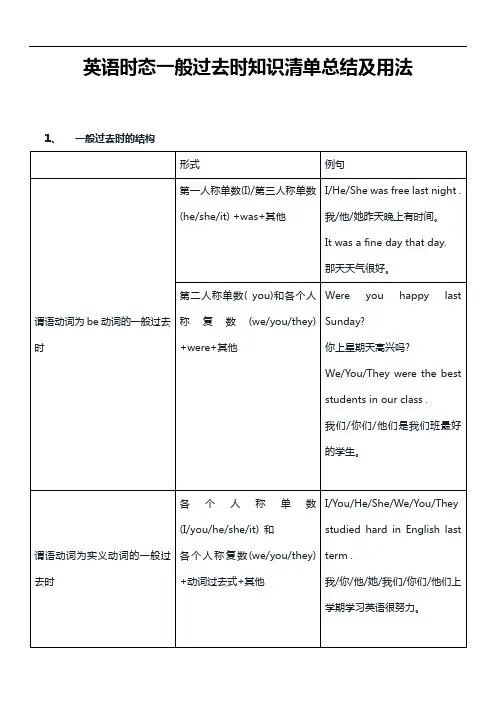
英语时态一般过去时知识清单总结及用法1、一般过去时的结构
2、一般过去时的结构变化
.
3、知识要点
一般过去时的用法
(1) 表示过去某一时间内发生的动作或存在的状态,常与表示过去的时间状语连用。
如:yesterday,last week,an hour ago(一个小时前),the other day(不久前的一天),just now(刚才),once upon a time(从前),in 1979(在1979年),in the old days(在过去的日子里)等。
如:Did you have a meeting yesterday ? 昨天你们开会了吗?
She left here just now. 她刚刚离开这儿。
My father got home at 10 o'clock last night. 我父亲昨晚十点到家。
We didn't have any money at that time . 那时候我们没有钱。
(2) 表示过去一段时间内经常或反复的动作或状态。
常与always (总是),never(从不)等连用。
如:
I never drank wine. 我从前从不喝酒。
She got up very early at that time . 她那时总是很早起床。
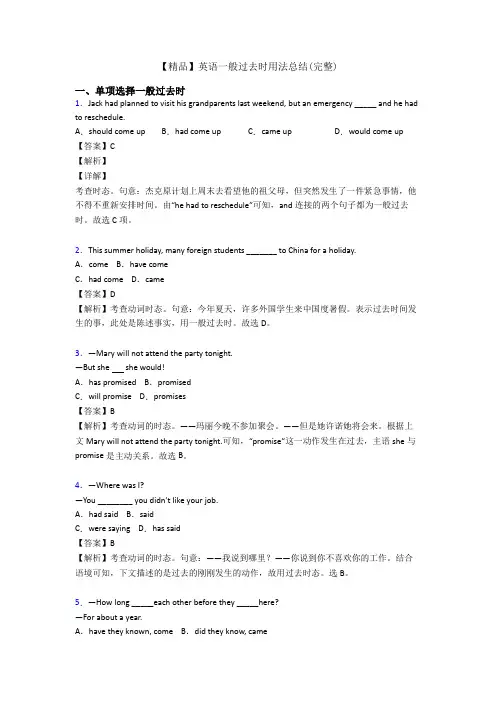
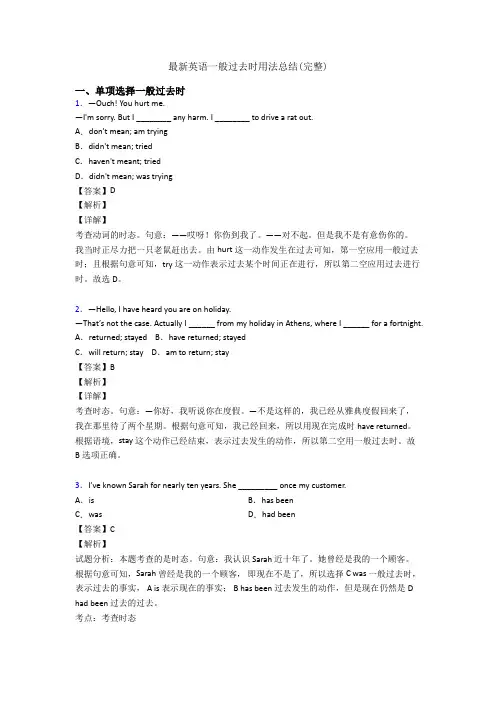
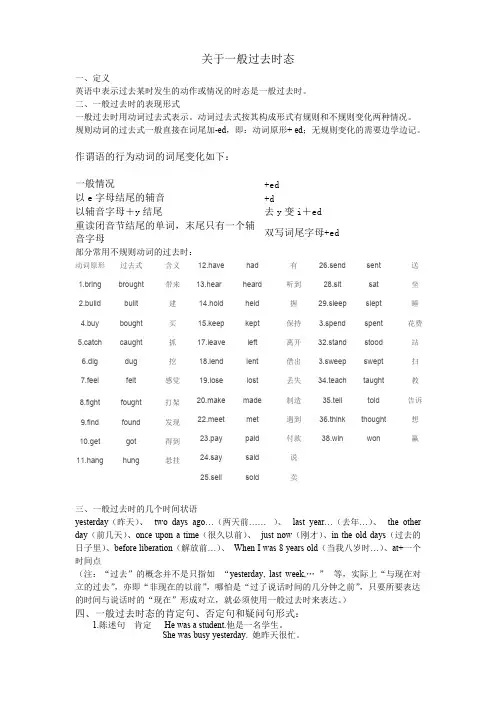
关于一般过去时态一、定义英语中表示过去某时发生的动作或情况的时态是一般过去时。
二、一般过去时的表现形式一般过去时用动词过去式表示。
动词过去式按其构成形式有规则和不规则变化两种情况。
规则动词的过去式一般直接在词尾加-ed,即:动词原形+ ed;无规则变化的需要边学边记。
作谓语的行为动词的词尾变化如下:一般情况+ed以e字母结尾的辅音+d以辅音字母+y结尾去y变i+ed重读闭音节结尾的单词,末尾只有一个辅音字母双写词尾字母+ed部分常用不规则动词的过去时:动词原形过去式含义1.bring brought带来2.build built建4.buy bought买5.catch caught抓6.dig dug挖7.feel felt感觉8.fight fought打架9.find found发现10.get got得到11.hang hung悬挂12.have had有13.hear heard听到14.hold held握15.keep kept保持17.leave left离开18.lend lent借出19.lose lost丢失20.make made制造22.meet met遇到23.pay paid付款24.say said说25.sell sold卖26.send sent送28.sit sat坐29.sleep slept睡3.spend spent花费32.stand stood站3.sweep swept扫34.teach taught教35.tell told告诉36.think thought想38.win won赢三、一般过去时的几个时间状语yesterday(昨天)、two days ago…(两天前…… )、last year…(去年…)、the other day(前几天)、once upon a time(很久以前)、just now(刚才)、in the old days(过去的日子里)、before liberation(解放前…)、When I was 8 years old(当我八岁时…)、at+一个时间点(注:“过去”的概念并不是只指如“yesterday, last week,…”等,实际上“与现在对立的过去”,亦即“非现在的以前”,哪怕是“过了说话时间的几分钟之前”,只要所要表达的时间与说话时的“现在”形成对立,就必须使用一般过去时来表达。
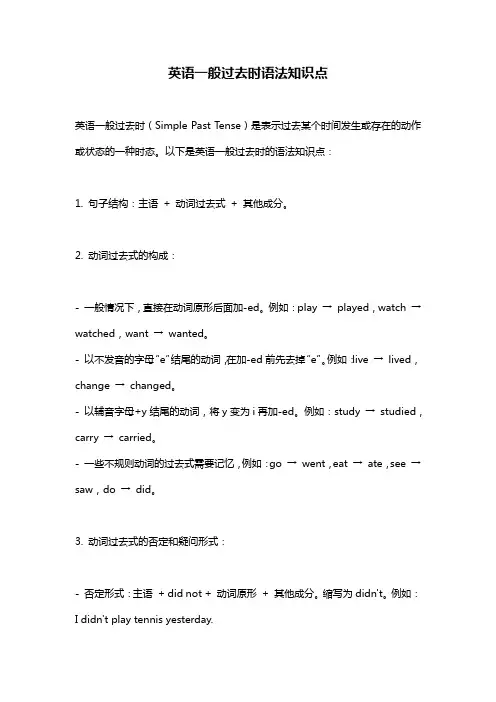
英语一般过去时语法知识点英语一般过去时(Simple Past Tense)是表示过去某个时间发生或存在的动作或状态的一种时态。
以下是英语一般过去时的语法知识点:1. 句子结构:主语+ 动词过去式+ 其他成分。
2. 动词过去式的构成:- 一般情况下,直接在动词原形后面加-ed。
例如:play →played,watch →watched,want →wanted。
- 以不发音的字母“e”结尾的动词,在加-ed前先去掉“e”。
例如:live →lived,change →changed。
- 以辅音字母+y结尾的动词,将y变为i再加-ed。
例如:study →studied,carry →carried。
- 一些不规则动词的过去式需要记忆,例如:go →went,eat →ate,see →saw,do →did。
3. 动词过去式的否定和疑问形式:- 否定形式:主语+ did not + 动词原形+ 其他成分。
缩写为didn't。
例如:I didn't play tennis yesterday.- 疑问形式:Did + 主语+ 动词原形+ 其他成分例如:Did you watch the movie last night?4. 一般过去时的时间状语:昨天(yesterday)、上个月(last month)、去年(last year)等表示过去某个具体时间的时间状语。
5. 一般过去时的用法:- 表示过去某个具体时间发生的动作或状态。
例如:I went to the beach yesterday.- 表示过去一段时间内发生的动作或状态。
例如:I lived in London for two years.- 表示过去习惯性的动作或状态。
例如:When I was a child, I always played with my friends.以上就是英语一般过去时的语法知识点。
记得多加练习,熟练掌握一般过去时的用法。
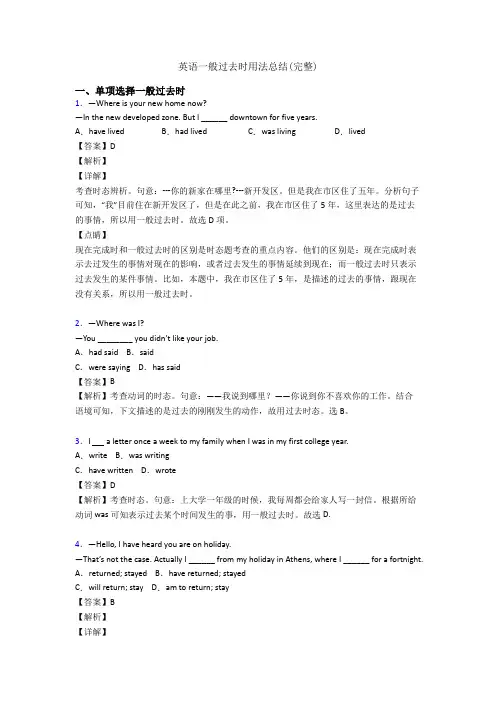
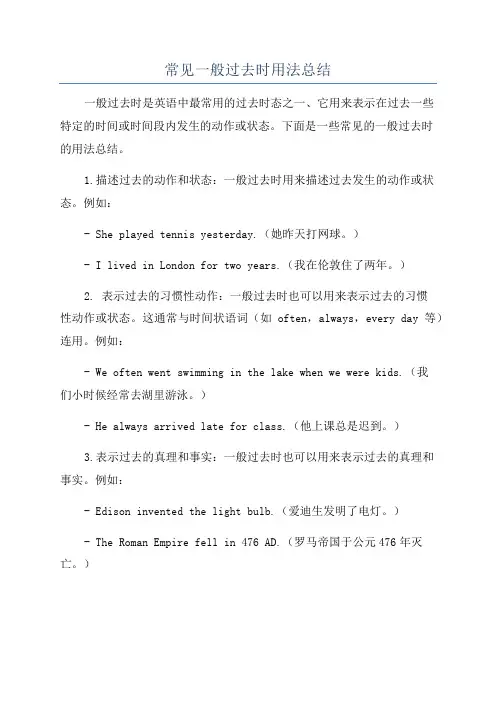
常见一般过去时用法总结一般过去时是英语中最常用的过去时态之一、它用来表示在过去一些特定的时间或时间段内发生的动作或状态。
下面是一些常见的一般过去时的用法总结。
1.描述过去的动作和状态:一般过去时用来描述过去发生的动作或状态。
例如:- She played tennis yesterday.(她昨天打网球。
)- I lived in London for two years.(我在伦敦住了两年。
)2. 表示过去的习惯性动作:一般过去时也可以用来表示过去的习惯性动作或状态。
这通常与时间状语词(如often,always,every day等)连用。
例如:- We often went swimming in the lake when we were kids.(我们小时候经常去湖里游泳。
)- He always arrived late for class.(他上课总是迟到。
)3.表示过去的真理和事实:一般过去时也可以用来表示过去的真理和事实。
例如:- Edison invented the light bulb.(爱迪生发明了电灯。
)- The Roman Empire fell in 476 AD.(罗马帝国于公元476年灭亡。
)4. 时间状语词的使用:一般过去时通常与过去的时间状语词连用,以指明动作发生的时间。
一些常见的过去时间状语词有yesterday(昨天),last week(上周),ago(之前)等。
例如:- I watched a movie yesterday.(我昨天看了一场电影。
)- She finished reading the book last week.(她上周读完了这本书。
)5. be动词的过去形式:一般过去时中,be动词的过去形式为was (用于第一人称单数,如I,he,she,it)和were(用于其他人称)。
例如:- I was tired after work.(工作后我很累。
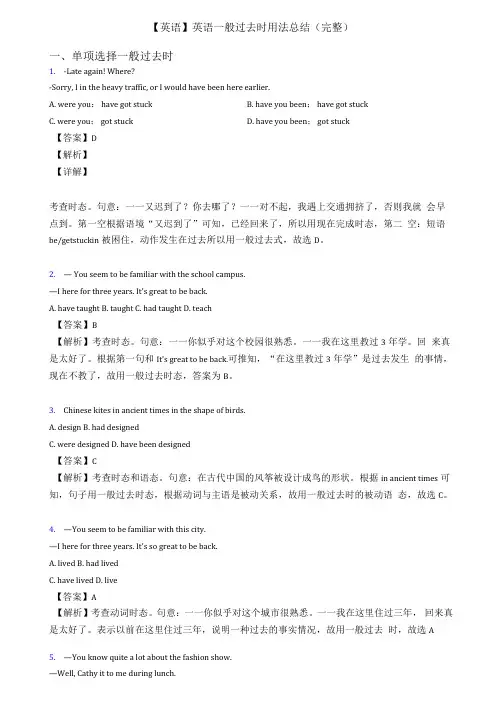
【英语】英语一般过去时用法总结(完整)一、单项选择一般过去时1.-Late again! Where?-Sorry, I in the heavy traffic, or I would have been here earlier.A. were you: have got stuckB. have you been; have got stuckC. were you; got stuckD. have you been; got stuck【答案】D【解析】【详解】考查时态。
句意:一一又迟到了?你去哪了?一一对不起,我遇上交通拥挤了,否则我就会早点到。
第一空根据语境“又迟到了”可知,已经回来了,所以用现在完成时态,第二空:短语be/getstuckin被困住,动作发生在过去所以用一般过去式,故选D。
2.— You seem to be familiar with the school campus.—I here for three years. It's great to be back.A. have taughtB. taughtC. had taughtD. teach【答案】B【解析】考查时态。
句意:一一你似乎对这个校园很熟悉。
一一我在这里教过3年学。
回来真是太好了。
根据第一句和It's great to be back.可推知,“在这里教过3年学”是过去发生的事情,现在不教了,故用一般过去时态,答案为B。
3.Chinese kites in ancient times in the shape of birds.A. designB. had designedC. were designedD. have been designed【答案】C【解析】考查时态和语态。
句意:在古代中国的风筝被设计成鸟的形状。
根据in ancient times可知,句子用一般过去时态,根据动词与主语是被动关系,故用一般过去时的被动语态,故选C。
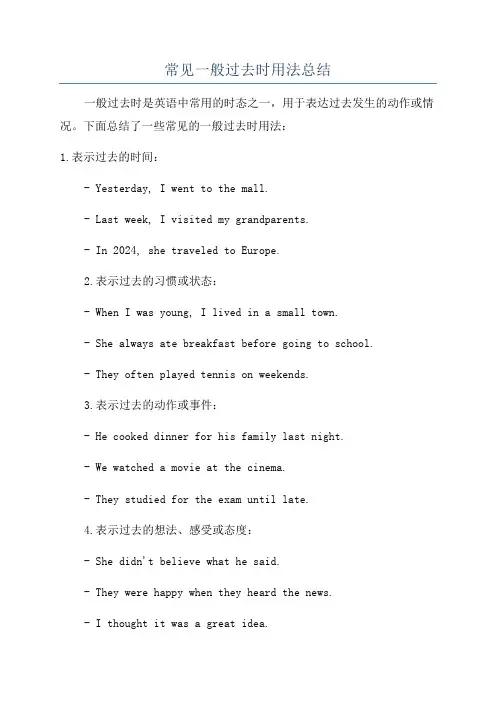
常见一般过去时用法总结一般过去时是英语中常用的时态之一,用于表达过去发生的动作或情况。
下面总结了一些常见的一般过去时用法:1.表示过去的时间:- Yesterday, I went to the mall.- Last week, I visited my grandparents.- In 2024, she traveled to Europe.2.表示过去的习惯或状态:- When I was young, I lived in a small town.- She always ate breakfast before going to school.- They often played tennis on weekends.3.表示过去的动作或事件:- He cooked dinner for his family last night.- We watched a movie at the cinema.- They studied for the exam until late.4.表示过去的想法、感受或态度:- She didn't believe what he said.- They were happy when they heard the news.- I thought it was a great idea.5.表示过去的条件或假设:- If I had known, I would have helped him.- I wish I had studied harder.- She would have won the race if she had trained more.6.表示过去经常性的动作或习惯:- Every day, she walked her dog in the park.- They always went to the beach during summer vacations.- He often played chess with his friends.7.表示过去的计划或安排:- We were supposed to meet at 5 o'clock, but he didn't show up.- They had booked tickets for the concert, but it was canceled.8.表示过去的建议或请求:- He suggested going to the new restaurant for dinner.- I asked him to help me with my homework.- She told me to be careful.9.表示过去的能力或可能性:- She could run very fast when she was younger.- He was able to speak three languages.- They might have gone to the party, but I'm not sure.10.表示过去的频率或数量:- He visited his grandparents twice a month.总结:一般过去时常用于描述过去发生的动作、状态、习惯和想法等。

初中英语知识点总结一般过去时一、一般过去时的用法:一般过去时表示过去发生或完成的动作、存在的状态或做过的事情。
1.表示过去一些时间发生的动作或存在的状态:- I played soccer yesterday.(我昨天踢足球。
)- He lived in Beijing when he was young.(他年轻时住在北京。
)2.表示过去的习惯性动作或经常发生的动作:- When I was a child, I always went to bed early.(我小的时候总是早睡。
)3.表示过去的客观事实或真理:- The dinosaurs died out millions of years ago.(恐龙在几百万年前灭绝了。
)- She didn't know the answer to the question.(她不知道问题的答案。
)4.表示过去的心理活动、愿望或打算等:- I wanted to be a doctor when I was young.(我年轻时想做一名医生。
)- He hoped to go to the park with his friends.(他希望和朋友去公园。
)二、一般过去时的构成:1.肯定句式:主语+动词的过去式+其他成分- I played basketball last week.- She lived in London for three years.- They watched a movie at the cinema yesterday.2.否定句式:主语 + did not / didn't + 动词原形 + 其他成分- I didn't play basketball last week.- She didn't live in London for three years.- They didn't watch a movie at the cinema yesterday.3.疑问句式:Did + 主语 + 动词原形 + 其他成分?- Did you play basketball last week?- Did she live in London for three years?- Did they watch a movie at the cinema yesterday?三、一般过去时的特殊情况:1.动词过去式的构成规则:a) 一般情况下,动词的过去式在词尾加上-ed:walk - walked(走)talk - talked(说话)play - played(玩)b)以字母e结尾的动词,在词尾只加-d:dance - danced(跳舞)c) 以辅音字母+y结尾的动词,将y变为i,再加-ed:study - studied(学习)d) 以重读闭音节结尾,末尾只有一个辅音字母的动词,双写这个辅音字母,再加-ed:stop - stopped(停止)plan - planned(计划)2.部分动词的过去式不规则,需要记忆:be - was / were(是)have - had(有)go - went(去)do - did(做)write - wrote(写)see - saw(看见)eat - ate(吃)drink - drank(喝)take - took(拿)四、表示一般过去时的时间状语:1.表示过去一些时间的状语:yesterday(昨天)last week(上星期)two days ago(两天前)2.表示过去的时间段的状语:when I was young(我年轻时)in my childhood(在我童年时)in the past(在过去)3.表示过去曾经做过的动作的状语:once(一次)五、注意事项:1. 一般过去时的句子中,谓语动词要用过去式,但be动词有时会用was或were。

关于英语一般过去时的用法一般过去时表示过去某个时间里发生的动作或状态;过去习惯性、经常性的动作、行为。
在英语语法中,“时“指动作发生的时间,”态“指动作的样子和状态。
那么如何运用同学们知道吗。
接下来小编在这里给大家带来英语一般过去时的用法,我们一起来看看吧!英语一般过去时的用法一、一般过去时的用法基本有六种:1、一般过去时表示在过去某个特定时间发生,也可以表示过去习惯性、经常性的动作。
一般不强调动作的影响,只说明的事情。
句式:主语+动词过去式+宾语+其它例句:I had a word with Julia this morning.今天早晨,我跟朱莉娅说了几句话。
2、一般过去时常与表示过去的时间状语或从句连用。
例句:He was dead in 1990.他死于1990年。
3、表示过去连续发生的动作时,要用过去时。
这种情况下,往往没有表示过去的时间状语,而通过上下文来表示。
例句:The boy opened his eyes for a moment,looked at the captain,and then died.那男孩把眼睛张开了一会儿,看看船长,然后就去世了。
4、表示在此之前一段时间内经常或反复的动作。
常与always,never等连用。
例句:Mrs. Peter always carried an umbrella.彼得太太过去老是带着一把伞。
5、如果强调已经终止的习惯时要用 used to do(过去常常做,而不那样做了)例句:He used to drink alcohol.他过去喝酒。
(意味着他不喝酒了。
喝酒这个动作终止了)6、有些句子,虽然没有表示过去确定时间的状语,但实际上是指过去发生的动作或存在的状态的话,也要用过去时。
I didn''t know you were in Paris.我不知道你在巴黎。
二、A say goes意思是俗话说,是一般现在时;A say went是一般过去时。
英语一般过去时语法知识点总结(笔记完整版)这一篇就够了1 一般过去时的定义总结1.1 描述发生在过去时间的事情或者动作。
The meeting started at 9 o’clock. 会议在9点就开始了。
1.2 表示在过去时间所存在的状态。
I was sick last month. 我上个月生病了。
1.3 表示发生在过去,但是已经结束的事件或者动作。
We had hamburger for lunch. 我们午饭吃了汉堡。
看下面表格区分一般过去时一般现在时和一般将来时一般过去时I was two years old then. 我那时候2岁。
一般现在时I am two years old now. 我现在2岁。
一般将来时I will be two years old next Monday. 到下周一我就2岁了。
2. 一般过去时的表现/结构形式。
在汉语中表示过去只需要说时间就可以了,过去的时间就表示过去。
比如,我昨天吃汉堡了。
就表示过去但是在英语中,表示过去除了加时间(有时候也不加),还需要在动词上体现出来。
具体有2种表现形式。
一种是在Be动词上体现,一种是在实义动词(能够独立做谓语的动词)上体现。
2.1 Be动词的一般过去时Be动词的一般过去时视主语不同,有2种was/were。
主语为单数或者我时,用was。
I was two years old last year. 我去年2岁She was two years old last year. 她去年2岁主语为复数或你时用were。
We were in the library this morning。
早上我们在图书馆You were thin last year。
你去年比较苗条。
Be动词过去时的肯定及否定肯定句结构:主语+was/were +否定句结构:主语+was/were +not+否定与的缩写结构was not = wasn’t , were not = weren’t例句:翠花去年是个胖子Cuihua was fat last year.翠花去年不胖Cuihua was not(wasn’t) fat last year.Be 动词过去时的一般疑问句,与常规一般疑问句一样,把Be动词提前即可。
初中英语知识点归纳一般过去时的用法一、一般过去时的定义和用法一般过去时用来表示过去发生的动作或存在的状态。
在一般过去时中,动词的过去式通常用于陈述句中,而表示过去发生的时间状语词也常常与一般过去时连用。
二、一般过去时的构成1.对于大多数动词,过去式是在动词原形结尾加上-ed,例如:- walk - walked- play - played- watch - watched2.以不发音的e结尾的动词,过去式只需加上-d,例如:- live - lived- love - loved3.以辅音字母+y结尾的动词,将y变为i,再加-ed,例如:- study - studied- try - tried4.以一个元音字母加一个辅音字母结尾的重读闭音节动词,双写最后一个辅音字母,再加-ed,例如:- stop - stopped- plan - planned注意:有些动词的过去式形式与原形一样,例如:- put - put- cut - cut三、一般过去时的用法1.表示过去某个时间发生的动作或事件,例如:- I went to the park yesterday.- They finished their homework last night.2.表示过去存在的状态,例如:- She was a nice girl when she was young.- It was sunny yesterday.3.表示过去的习惯或经常性动作,例如:- When I was young, I played basketball every day.- They often went fishing on weekends.4.在宾语从句中,当主句是过去时,宾语从句的动词也要用一般过去时,例如:- He said that he watched a movie last night.- She told me that she visited her grandparents on the weekend.5.与表示过去具体时间的状语连用,例如:- I saw him two days ago.- We had a great time at the party last week.四、一般过去时的注意事项1.注意动词的变化形式,特别是不规则动词的过去式,需要进行记忆和练习。
一般过去时的用法归纳一般过去时是英语中最常用的时态之一,用于描述过去发生的事情、状态或习惯。
下面是一般过去时的用法总结:1.表示过去的动作或事件:-They went to the park yesterday.(他们昨天去了公园。
)-She cooked dinner for us last night.(昨晚她给我们做了晚餐。
)2.表示过去的习惯或常态:-He always walked to work when he lived in the city.(当他住在城市里时,他总是走路上班。
)-We used to play soccer every weekend.(我们过去每个周末都踢足球。
)3.表示过去的状态或条件:-The house was very old and dusty.(那所房子又旧又脏。
)-I was tired after a long day at work.(工作一整天后,我感到很累。
)4.与时间状语连用:-He studied English for two hours yesterday.(他昨天学习了两个小时的英语。
)-She visited her grandparents last summer.(去年夏天她拜访了她的祖父母。
)需要注意的是,在一般过去时中,动词的变化规则如下:-对于大多数动词,过去式是在动词原形后加上-ed,例如:talked, walked,played。
-以不发音的-e结尾的动词,只需加上-d,例如:lived,loved。
-以重读闭音节结尾,并且末尾只有一个辅音字母的动词,需双写末尾的辅音字母,并加上-ed,例如:stopped,planned。
综上所述,一般过去时是用来描述过去发生的动作、状态或习惯的时态。
在使用一般过去时时,我们需要注意动词的过去式变化规则,并与适当的时间状语连用,以使表达更加准确和清晰。
【精品】英语一般过去时用法总结(完整)一、单项选择一般过去时1.Only ________ as a translator ________ how important it is to understand foreign cultures. A.when did I work; I realized B.when I worked; I realizedC.when did I work; did I realize D.when I worked; did I realize【答案】D【解析】试题分析:考查only位于句首用法。
Only +状语(或从句),位于句首,用部分倒装 (即疑问句语序),即主句倒装,句意:只有当我作为一个翻译官时我才意识到理解外国文化有多重要。
故选D考点:考查only位于句首用法2.— You seem to be familiar with the school campus.—I ______ here for three years. It’s great to be back.A.have taught B.taught C.had taught D.teach【答案】B【解析】考查时态。
句意:——你似乎对这个校园很熟悉。
——我在这里教过3年学。
回来真是太好了。
根据第一句和It’s great to be back.可推知,“在这里教过3年学”是过去发生的事情,现在不教了,故用一般过去时态,答案为B。
3.—Mary will not attend the party tonight.—But she she would!A.has promised B.promisedC.will promise D.promises【答案】B【解析】考查动词的时态。
——玛丽今晚不参加聚会。
——但是她许诺她将会来。
根据上文Mary will not attend the party tonight.可知,“promise”这一动作发生在过去,主语she与promise是主动关系。
初中英语一般过去时的用法与辨析一、一般过去时的基本结构1. 肯定句形式:主语+动词过去式+其他 I was an English teacher one year ago.一年前我是一名英语老师。
I bought a yellow dress yesterday afternoon.昨天下午我买了一条黄裙子。
2. 否定句形式:①was/were+not; ②在行为动词前加didn't,同时还原行为动词 I wasn't an English teacher one year ago.一年前我不是一名英语老师。
I didn't buy a yellow dress yesterday afternoon.昨天下午我没买一条黄裙子。
3. 一般疑问句:①was/were提到句首;②Did+主语+动词原形+其他? Were you an English teacher one year ago?一年前你是一名英语老师吗?Did you buy a yellow dress yesterday afternoon?昨天下午你买了一条黄裙子吗?二、一般过去时的基本用法1. 表示在过去某个时间所发生的动作或所处的状态(与现在无关) 。
常与yesterday, last week, in 1989, just now, a moment ago, the other day等过去具体时间状语连用。
He was here just now.他刚才还在这里。
What did you do yesterday?你昨天做了什么事?2. 在过去一段时间内的经常性或习惯性动作。
We often played together when we were children.我们小时候常在一起玩。
注:表示过去经常发生的动作还可用used to 和would。
He used to smoke a lot, but he doesn’t now.他过去经常抽烟,但现在不抽了。